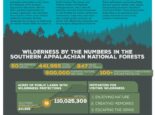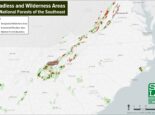Protecting our Southern Appalachian forests
Benefits of national forests in the South
Spanning nearly five million acres from Virginia to Alabama, the national forests that blanket our Southern Appalachians mountains provide habitat for a diverse array of fish and wildlife, safeguard our drinking water supplies, and contribute millions to our economy. The George Washington & Jefferson, Pisgah, Nantahala, Cherokee and Chattahoochee National Forests, along with the Andrew Pickens District of the Sumter National Forest, are some of the most accessible and beloved public lands in the country with endless opportunities for hiking, camping, picnicking or other recreational activities.
National forests also provide an essential piece of tackling climate change. The federal government is responsible for 30% of our nation’s forests, primarily through the Forest Service, and these areas include some of the world’s biggest existing carbon sinks. Using Southern Appalachian forests to store carbon will become increasingly important as climate change continues to impact people in the South and around the world.
National forests face a unique set of threats
National forests, unlike other types of public lands, are managed for multiple purposes. While the forests are used to preserve wildlife habitats and create space for recreational activities, they are also utilized for timber harvesting and other commercial projects. These conflicting goals can lead to unique threats, including irresponsible logging, unnecessary road construction projects, or private uses like utility infrastructure, that leave long-lasting scars on public forest lands.
Especially at risk are mature, hardwood forests that contain wildlife habitat and patches of rare remaining old growth forests, headwater streams that feed drinking water supplies, and places beloved by hikers, anglers, and others who enjoy backcountry recreation. Threats to these special ecosystems are worsened by the Forest Service’s continued use of crude timber targets, which measure local officials’ performance by the volume of timber harvested or acres logged. We challenge these misguided proposals at the local level and bad policies at the regional and national level in order to protect ecological and scenic treasures that are vital to the Southeast.
SELC provides priceless strategy, counsel, and policy expertise and communicates our values in a way that state and federal agencies understand. Without SELC, we would have much less success in protecting public land.
Josh Kelly, MountainTrue
How we protect national forests
Preserving these forests has been at the heart of SELC’s mission from the day we opened our doors in 1986. In that time, we have become a national leader in forest advocacy by creating a sustained presence in the Southern Appalachian’s national forests and by working in partnership with local partners and, when possible, with US Forest Service staff. We advocate for the agency to end crude timber targets for ranger districts, create a clear policy that bans logging of old-growth forests, and to emphasize carbon storage as a Forest Service goal.
While we use a variety of approaches to defend the Southern Appalachian forests, our greatest leverage comes in shaping the Forest Service’s management plans that decide a national forest’s future for 15 or more years at a time. We work to influence these plans so the Forest Service will recognize and prioritize the importance of protecting ecologically valuable areas, including by prohibiting logging from certain critical areas or excluding destructive practices such as natural gas fracking. This allows us to work together in subsequent years on positive projects that move our conservation vision forward. We have been very successful at steering the US Forest Service away from bad ideas and, in relatively few cases, pushing back particularly reckless projects through litigation.
Recent news on Southern Appalachian forests
Additional Resources


